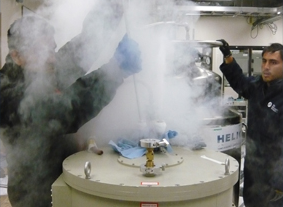
LMT staff and students during a Helium transfer for AzTEC, one of the LMT commissioned instruments available for early science observations.
The RSR and AzTEC, a wide-band 3 mm spectrometer and a 1.1 mm continuum camera respectively, conducted the first-light scientific demonstration observations on the LMT in June and July 2011. Both instruments were available for the different shared-risk Early Science campaigns, which began in the spring of 2013. AzTEC is no longer available and has been de-commissioned in preparation to receive TolTEC, the new continuum camera that will simultaneously observe at 1.1, 1.4 and 2.0 mm.
The current suite of LMT instrumentation includes four heterodyne receivers (SEQUOIA, Redshift Search Receiver (RSR), B4R and MSIP1mm) and one continuum instrument (TolTEC). SEQUOIA, a high resolution spectrometer at 3mm, was installed and commissioned in 2017, and was offered for science observations in the 2018-S1 Call for Proposals. MSIP1mm, a dual polarization, sideband separation receiver for the 210-280 GHz frequency band, was also installed and commissioned in 2017, primarily to be used for observations with the Event Horizon Telescope (EHT), but also available for general astronomical observations. The B4R, a single-beam two-polarization receiver system that operates in the 2mm band, based on ALMA band-4 “2SB” and developed by the National Astronomical Observatory of Japan, was installed and commissioned in 2018 and demonstration science observations were performed in Autumn 2019.
Additionally, the LMT has further developed the capability for Very Long Baseline Interferometry (VLBI: at 3mm with the RSR and at 1.3mm with MSIP1mm).
A program of instrument development continues to take advantage of technological advances in the on-going effort to provide the next-generation of state-of-the-art LMT instruments (e.g. the large format continuum camera, TolTEC, and the 1mm spectroscopic imaging array, OMAyA).